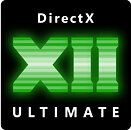- Joined
- Oct 9, 2007
- Messages
- 47,180 (7.56/day)
- Location
- Hyderabad, India
| System Name | RBMK-1000 |
|---|---|
| Processor | AMD Ryzen 7 5700G |
| Motherboard | ASUS ROG Strix B450-E Gaming |
| Cooling | DeepCool Gammax L240 V2 |
| Memory | 2x 8GB G.Skill Sniper X |
| Video Card(s) | Palit GeForce RTX 2080 SUPER GameRock |
| Storage | Western Digital Black NVMe 512GB |
| Display(s) | BenQ 1440p 60 Hz 27-inch |
| Case | Corsair Carbide 100R |
| Audio Device(s) | ASUS SupremeFX S1220A |
| Power Supply | Cooler Master MWE Gold 650W |
| Mouse | ASUS ROG Strix Impact |
| Keyboard | Gamdias Hermes E2 |
| Software | Windows 11 Pro |
Microsoft Thursday released the DirectX 12 Ultimate logo. This is not a new API with any new features, but rather a differentiator for graphics cards and game consoles that support four key modern features of DirectX 12. This helps consumers recognize the newer and upcoming GPUs, and tell them apart from some older DirectX 12 capable GPUs that were released in the mid-2010s. For a GPU to be eligible for the DirectX 12 Ultimate logo, it must feature hardware acceleration for ray-tracing with the DXR API; must support Mesh Shaders, Variable Rate Shading (VRS), and Sampler Feedback (all of the four). The upcoming Xbox Series X console features this logo by default. Microsoft made it absolutely clear that the DirectX 12 Ultimate logo isn't meant as a compatibility barrier, and that these games will work on older hardware, too.
As it stands, the "Navi"-based Radeon RX 5000 series are "obsolete", just like some Turing cards from the GeForce GTX 16-series. At this time, the only shipping product which features the logo is NVIDIA's GeForce RTX 20-series and the TITAN RTX, as they support all the above features.

Microsoft's announcement of the logo invited quick reactions from NVIDIA and AMD. NVIDIA has reason to gloat that its circa Q3-2018 GeForce RTX 20-series are already DirectX 12 Ultimate logo certified, and gloat it did. AMD, on the other hand, was left to content with the fact that Xbox Series X has this logo, as its upcoming RDNA2 graphics architecture powers the console's GPU; and an assurance that its next-generation of Radeon RX graphics cards will feature the logo. Intel posted no reaction to this development, since none of its current iGPUs cut the requirements. Gen11 "Ice Lake" supports VRS tier-1, something RDNA doesn't. It's been rumored that the company's larger Xe discrete GPUs (those with two-figure TFLOPs), could implement DXR-compliant ray-tracing.
In our opinion, the introduction of the DirectX 12 Ultimate logo will spark a sense of urgency within AMD's ranks to launch next-gen Radeon RX graphics cards based on the RDNA2 architecture. It will also give Microsoft a vehicle that lets them fight the Sony Playstation 5 hardware capabilities. Perhaps with this logo, Microsoft is trying to communicate that its Xbox Series X console is as capable as PCs with GeForce RTX 20-series graphics cards (which is very much qualified, if you look at the console's hardware specs sheet).
NVIDIA has had raytracing for over a year, with mixed success in terms of adoption rates and how willing gamers were to pay for it. Still, right now, in people's minds, NVIDIA is the raytracing company — the only one. While Microsoft could admit "we've joined the raytracing party, two years later", they innovated their way out of this by creating a new certification that they could announce themselves, to bring parity back to mindsets of gamers. Remember, there's still quite some time before the new consoles release — plenty of time for marketing to work its magic.
Back when DirectX 12 was launched, Microsoft announced that it would be the "last DirectX" — a decision which has been effectively reverted now, because the company has realized the marketing value of new names, badges and stickers. Now of course this will simplify things for gamers that are not hardware experts. They can simply look for the DirectX 12 Ultimate Badge and know they will have what it takes to run the latest titles with all their features — whether that translates into playable framerates on the PC platform remains to be seen.
Microsoft's push for DirectX 12 should also nudge developers to embrace the DirectX 12 API. So far, DirectX 12 has seen very little adoption rate from game developers, with the vast majority of titles using DirectX 11, which is much simpler to develop for, too. Maybe we'll even see the DirectX 12 Ultimate Logo associated with games — to highlight that a game uses the four magical features, and will thus deliver next-gen graphics. The dark horse in consumer graphics is the Vulkan API by Khronos Group. There are plenty of AAA games that provide next-gen eye-candy with this API. It's supported across multiple PC operating systems, and is implemented alongside OpenGL in PlayStation 5. It also has a full-fleged ray-tracing feature-set. Microsoft could also be targeting Vulkan's growing popularity.
Variable Rate Shading is one of the key ingredients for next-gen consoles being able offer smooth 4K gaming. Consoles set the technological minimums for game developers, and it would pay to have a graphics card that's at least aligned with an Xbox Series X in terms of features, if not performance.
View at TechPowerUp Main Site
As it stands, the "Navi"-based Radeon RX 5000 series are "obsolete", just like some Turing cards from the GeForce GTX 16-series. At this time, the only shipping product which features the logo is NVIDIA's GeForce RTX 20-series and the TITAN RTX, as they support all the above features.

Microsoft's announcement of the logo invited quick reactions from NVIDIA and AMD. NVIDIA has reason to gloat that its circa Q3-2018 GeForce RTX 20-series are already DirectX 12 Ultimate logo certified, and gloat it did. AMD, on the other hand, was left to content with the fact that Xbox Series X has this logo, as its upcoming RDNA2 graphics architecture powers the console's GPU; and an assurance that its next-generation of Radeon RX graphics cards will feature the logo. Intel posted no reaction to this development, since none of its current iGPUs cut the requirements. Gen11 "Ice Lake" supports VRS tier-1, something RDNA doesn't. It's been rumored that the company's larger Xe discrete GPUs (those with two-figure TFLOPs), could implement DXR-compliant ray-tracing.
In our opinion, the introduction of the DirectX 12 Ultimate logo will spark a sense of urgency within AMD's ranks to launch next-gen Radeon RX graphics cards based on the RDNA2 architecture. It will also give Microsoft a vehicle that lets them fight the Sony Playstation 5 hardware capabilities. Perhaps with this logo, Microsoft is trying to communicate that its Xbox Series X console is as capable as PCs with GeForce RTX 20-series graphics cards (which is very much qualified, if you look at the console's hardware specs sheet).
NVIDIA has had raytracing for over a year, with mixed success in terms of adoption rates and how willing gamers were to pay for it. Still, right now, in people's minds, NVIDIA is the raytracing company — the only one. While Microsoft could admit "we've joined the raytracing party, two years later", they innovated their way out of this by creating a new certification that they could announce themselves, to bring parity back to mindsets of gamers. Remember, there's still quite some time before the new consoles release — plenty of time for marketing to work its magic.
Back when DirectX 12 was launched, Microsoft announced that it would be the "last DirectX" — a decision which has been effectively reverted now, because the company has realized the marketing value of new names, badges and stickers. Now of course this will simplify things for gamers that are not hardware experts. They can simply look for the DirectX 12 Ultimate Badge and know they will have what it takes to run the latest titles with all their features — whether that translates into playable framerates on the PC platform remains to be seen.
Microsoft's push for DirectX 12 should also nudge developers to embrace the DirectX 12 API. So far, DirectX 12 has seen very little adoption rate from game developers, with the vast majority of titles using DirectX 11, which is much simpler to develop for, too. Maybe we'll even see the DirectX 12 Ultimate Logo associated with games — to highlight that a game uses the four magical features, and will thus deliver next-gen graphics. The dark horse in consumer graphics is the Vulkan API by Khronos Group. There are plenty of AAA games that provide next-gen eye-candy with this API. It's supported across multiple PC operating systems, and is implemented alongside OpenGL in PlayStation 5. It also has a full-fleged ray-tracing feature-set. Microsoft could also be targeting Vulkan's growing popularity.
Variable Rate Shading is one of the key ingredients for next-gen consoles being able offer smooth 4K gaming. Consoles set the technological minimums for game developers, and it would pay to have a graphics card that's at least aligned with an Xbox Series X in terms of features, if not performance.
View at TechPowerUp Main Site









